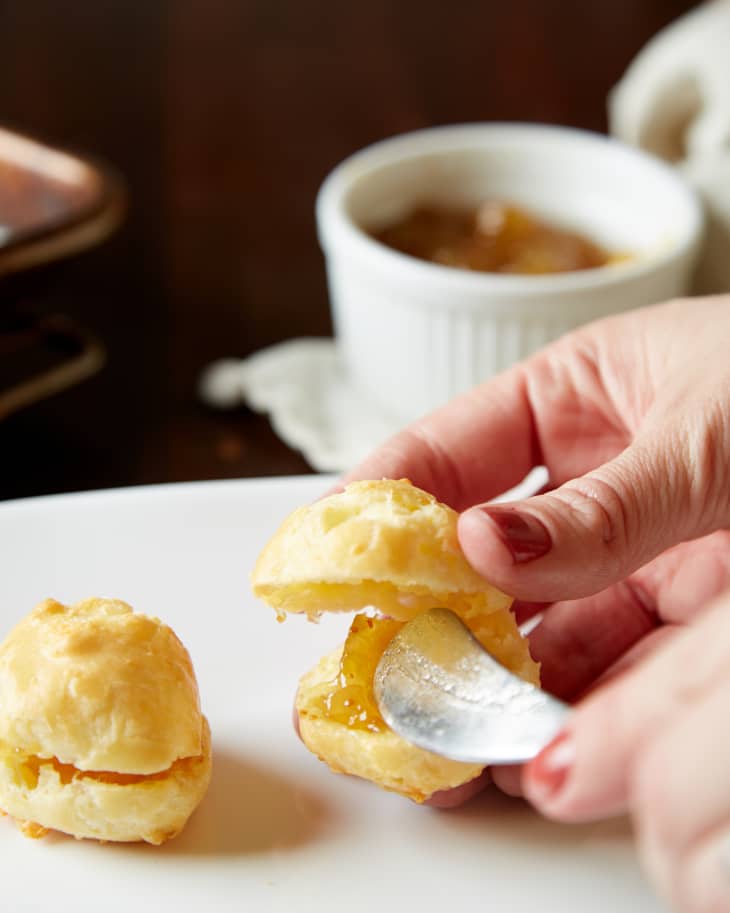Recipe: Gougères with Fig Jam

Serves8
Fried jelly doughnuts, called sufganiyot, are a common Hanukkah treat in Israel, and are increasingly popular in the United States. But while homemade doughnuts filled with strawberry or raspberry jam are delicious as a once-in-a-while treat, they make the house smell like fried food and leave a pesky amount of cooking oil behind to dispose of.
These gougères, which come sandwiched with fig preserves, offer a savory, sophisticated twist on sufganiyot. Light and airy, their texture mimics a yeasted doughnut without the frying. The sweet jam, meanwhile, nicely offsets the savory puffs’ flavor. Gougères dough, which is made on the stovetop, can be a little intimidating to work with at first — particularly for those who have never tried it. But keep stirring briskly, and it will come together. The payoff is well worth the extra bit of elbow grease.
Gougères with Fig Jam
Serves 8
Nutritional Info
Ingredients
- 6 tablespoons
unsalted butter, cut into 4 pieces
- 3/4 teaspoon
kosher salt
- 1 1/4 cups
all-purpose flour
- 4
large eggs
- 1 cup
shredded cheddar cheese
- 1/2 cup
shredded Parmesan cheese
- 1/2 teaspoon
freshly ground black pepper
- 1
large egg yolk
About 1 cup fig jam or preserves
Instructions
Arrange 2 racks to divide the oven into thirds and heat to 400°F. Line 2 rimmed baking sheets with parchment paper; set aside.
Place the butter, salt, and 1 cup of water in a medium saucepan over medium-high heat. Bring to a boil, stirring until the butter is fully melted. Remove from heat, add the flour, and stir until the flour is evenly moistened.
Place the saucepan back over medium heat. Cook, stirring constantly with a wooden spoon, until the mixture pulls away from the sides of the pan and begins to form a ball, 1 to 2 minutes. Continue cooking, stirring constantly, until the dough is no longer sticky, about 2 minutes more. Remove pan from the heat and let dough cool slightly, about 2 minutes.
Stir the whole eggs in one at a time, making sure each egg is fully incorporated before adding the next. Add the cheddar cheese, Parmesan, and pepper and stir to combine.
Transfer the dough into a piping bag fitted with a 1/2-inch round tip, or into a large, plastic zip-top bag with a 1/2-inch opening cut diagonally from one bottom corner. Pipe 1-inch rounds about 2 inches apart on the prepared baking sheets.
Place the egg yolk and 1 teaspoon of water in a small bowl and whisk to combine. Brush the dough rounds with egg wash.
Bake until puffed, golden, and set in the center (they should sound hollow when tapped), 20 to 25 minutes. Remove the baking sheets from the oven and set on wire racks until cool to the touch.
Use a sharp, serrated knife to slice each gougère sideways almost in half, being careful not to cut all the way through the gougère. Spread about 1 teaspoon fig preserves inside each gougère, then close up again.
Recipe Notes
Make ahead: Freeze the egg-washed dough rounds until solid, then transfer to an airtight container or a zip-top bag and freeze for up to 2 months. Bake straight from the freezer, they made need a few minutes extra baking time.
Storage: Leftovers not filled with fig jam can be stored in the refrigerator for up to 5 days or frozen for up to 3 months. Re-crisp in a warm oven before serving.
Reprinted with permission from Little Book of Jewish Appetizers by Leah Koenig, copyright (c) 2017. Published by Chronicle Books.
